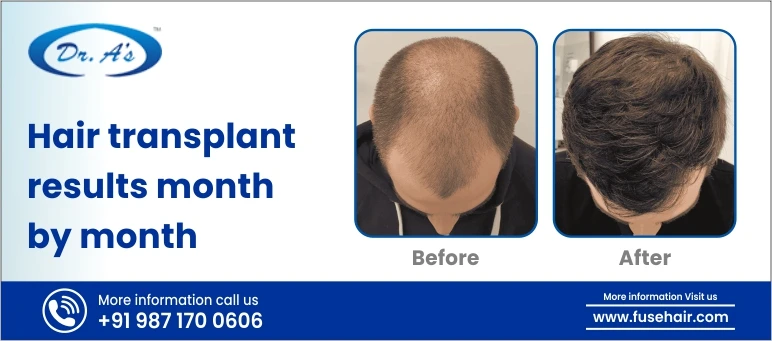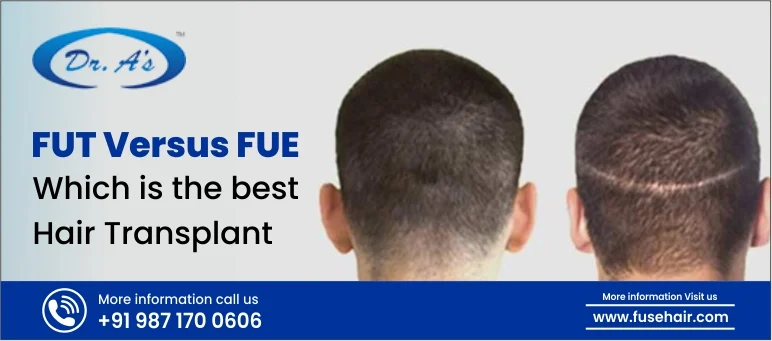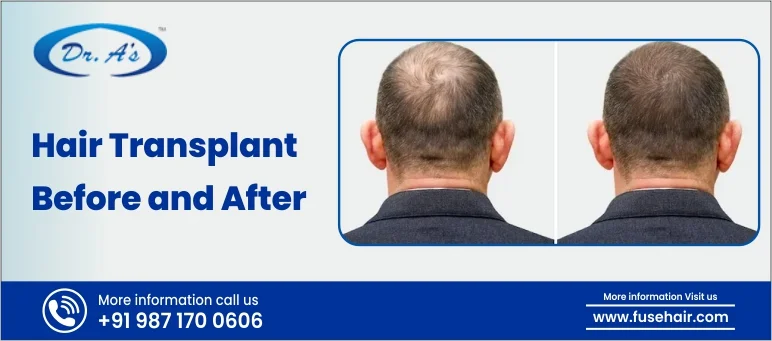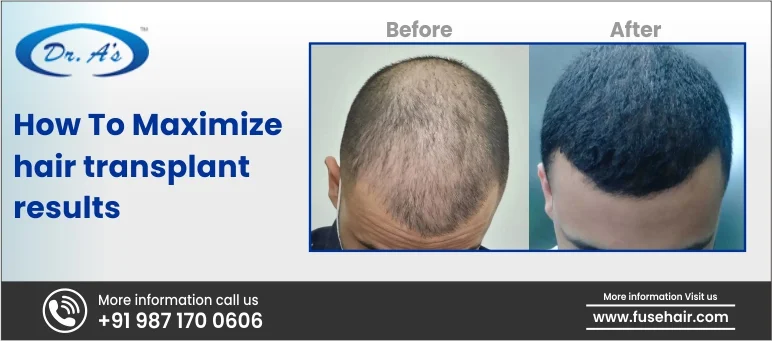
- September 12, 2023
- fusehair
- 0
Table of Contents
ToggleHow do hair transplants work?
A hair transplant is a surgical procedure involving the transplantation of hair follicles from a donor area to the recipient area, typically an area of the scalp experiencing hair loss or thinning. The procedure is performed under local anesthesia to ensure the patient’s comfort. The best hair transplant results are produced using these two procedures.- FUT
In FUT, a strip of skin containing hair follicles is surgically removed from the donor area, usually from the back or sides of the scalp. The donor area is then sutured, leaving a fine linear scar that can be easily concealed. The strip of skin is dissected into individual follicular units, which consist of one to four hairs each. These follicular units are meticulously transplanted into tiny incisions made in the recipient area by the surgeon.
-
FUE
In FUE, individual hair follicles are extracted directly from the donor area using a small device. The surgeon makes tiny circular incisions around each follicular unit and removes them carefully. The extracted follicular units are then transplanted into the recipient area. This process is best suited for those with thinning hair.
It has grown in popularity compared to FUT as this procedure can help circumvent a mismatch in the look of the transplanted hair with the hair of the surrounding area. FUE hair transplant results are long-lasting and produce a satisfactory boost in the quality and volume of the patient’s hair.
Both FUT and FUE hair transplant results depend on the precision and artistic skill of the doctor to create natural-looking results and avoid the mismatched “hair plug” look. The success of a hair transplant largely depends on the surgeon’s expertise, the quality of the donor’s hair, and the patient’s characteristics.
So, if you want to undergo an effective, long-lasting FUT or FUE hair transplant procedure, consult Dr. Arvind Poswal. His skilled technical executions and years of expertise ensure long-term success.
Why does it take time for hair to regrow after a hair transplant?
A hair transplant does not imply an instantaneous fixation of existing hair onto a new area where it’s lacking. It is a process where follicles are grafted onto a recipient area. Therefore, a few factors influence the time it takes to witness a significant hair transplant before and after difference. The four main factors are:
-
Hair Growth Cycle
Hair follicles naturally undergo a growth cycle consisting of active growth (anagen phase), a transitional phase (catagen phase), and a resting phase (telogen phase). After a hair transplant, the transplanted follicles initially enter a resting phase before starting to regrow. This delay is a normal part of the hair growth cycle and contributes to the gradual regrowth of transplanted hair.
-
Healing and Revascularization
Following the transplant surgery, the transplanted hair follicles need time to establish a blood supply in the recipient area. The process of revascularization involves the growth of new blood vessels to nourish the transplanted follicles. This healing and revascularization period is crucial for the survival and regrowth of the transplanted hair.
-
Natural Hair Growth Rate
Hair grows relatively slowly, typically about half an inch per month on average. This natural hair growth rate applies to the transplanted hair as well. It takes time for the transplanted follicles to adapt to their new environment, resume growth, and gradually achieve noticeable length and density.
-
Maturation and Thickening
Over time, the transplanted hair follicles undergo a maturation process. The initially thin and fine hair gradually thickens and gains strength, resulting in a more natural appearance. This maturation process can take several months, and patients eventually observe significant improvements in hair quality and thickness between hair transplant before and after conditions.
A month-by-month look at the different stages of hair transplant results
For the people who are getting hair transplants, it can be of great help to have a basic understanding of the results that the surgery produces. Here’s a 12-month timeline with hair transplant before and after results:
-
Month 1: The Early Stages
The first month after hair transplant surgery primarily involves healing the scalp. Patients may experience some initial discomfort during this period when the new hair has been grafted. Small, pinhead-sized scabs, along with swelling and mild itchiness, may trouble the donor and recipient area.
These symptoms are not a cause for alarm and usually mitigate on their own within 7-10 days. They are a part of the healing procedure, and you should strictly follow the post-operative instructions provided by the surgeon to ensure proper care of your scalp.
After about a month has passed, the transplanted hair follicles may now enter a shedding phase known as “shock loss.” During this process, the transplanted hair suddenly falls out, only to grow back fully after some time. This usually happens in the peripheral area adjacent to where the graft was performed and is a normal part of the hair regrowth process. It may also happen at the donor site but is usually more common in the form. Shock loss occurs due to trauma sustained by the tissue during the hair transplant surgery and is not a cause for concern.
-
Month 2-3: First Significant Signs of Growth
Patients may notice the first significant signs of hair growth during the second and third months. A sparse dusting of fine delicate strands will appear, short and thin in dimension. Although these initial hair appearances may not seem dense or strong enough, their “popping” through the scalp is an important sign of the procedure’s success and proper progress toward full recovery. Starting from this, the hairs usually will now grow at the rate of one centimeter every month, gaining thickness with time.
Patients should continue to follow the aftercare instructions provided by their surgeon and refrain from applying unnecessary pressure or trauma to the scalp. Maintaining a gentle hair care routine is essential to avoid dislodging the newly transplanted hair. All these measures will provide you with effective and successful hair transplant result after 3 months.
-
Month 4-6: Visible Improvements
Patients usually observe a more noticeable improvement in hair density and thickness by the fourth month. The transplanted hair will continue to grow, gradually blending with the existing hairline and creating a more natural appearance. However, it is important to remember that hair growth is a gradual process, and individual results may vary.
For hair transplant result in five months, it is common for some patients to experience minor irregularities, such as uneven growth or areas with slower progress. Patience is key during this period, as the transplanted hair matures and thickens over time.
-
Month 7-9: Enhanced Hair Quality
Patients will witness significant progress in hair quality and overall appearance between the seventh and ninth months. The hair will become stronger, thicker, and more resilient. The growth pattern will continue to improve, and any unevenness from the earlier stages will likely resolve itself. During this time, your hair will also start looking much more natural compared to the surrounding areas as it begins assimilating with its counterparts on the scalp.
-
Month 10-12: Final Results
By the tenth month, patients can expect the final results of their hair transplant procedure. The hair growth will be more consistent, resembling the patient’s natural hairline and density. It is important to note that individual results can still vary depending on factors such as the patient’s overall health, genetic predisposition, and the quality of the transplantation procedure.
Maintaining the Results
After the first year’s completion, patients can enjoy their new, restored hairline. They’ll now be able to witness a major difference between hair transplant before and after results. However, it is essential to maintain a proper hair care routine and make necessary lifestyle adjustments to ensure the longevity of the results. This may include protecting the scalp from excessive sun exposure, avoiding harsh chemicals, and maintaining a healthy diet and lifestyle.
Conclusion
A hair transplant procedure has developed into perhaps the most reliable solution for individuals experiencing hair loss. Gone are the days when a receding hairline would signal the imminent onset of irreversible baldness. You no longer need to shave off your thinning hair or worry about your self-esteem plummeting due to early bald patches. You can opt for an effective hair transplant procedure by Dr. Arvind Poswal, Delhi’s best hair transplant surgeon.
He possesses all the stellar qualities that are to be expected of a world-class surgeon. With 20+ years of experience in the field, he has treated numerous patients from around the world. He was the first person to perform the body hair to scalp transplant (BHT) in 1999 and is credited for pioneering the stitchless FUSE/ FUE technique. In his expert hands, you can expect the best hair transplant results.
FAQ
-
How many months after a hair transplant do you see results?
After a hair transplant operation, results normally show up three to four months later. To observe the complete effects, though, it may take up to eight months or a year. As is typical for the hair growth cycle, the transplanted hair follicles may initially experience a period of shedding. Following this period of hair loss, patients start to notice noticeable improvements in their coverage and density of hair. As the transplanted hairs develop and mix in with the surrounding hair, the effects will gradually improve over time.
-
What are the results of hair transplant monthly?
The results of a hair transplant appear gradually over a few months. Patients may suffer some redness or swelling in the donor and recipient areas during the first month following transplant, as well as a brief loss of the transplanted hair follicles. New hair usually starts to grow by the second or third month, though it could look sparse and thin at first. Hair growth starts to show in the fourth and sixth month, and as more transplanted hairs reach the active development phase, the density gets better. The transplanted hair continues to grow and mature by the sixth to twelfth month, thickening and merging in with the native hair. Overall, by the end of the first year following transplant, patients typically observe noticeable improvements in hair coverage and density.
-
Is my hair still thin at 5 months?
Five months after transplant, it’s normal for the transplanted hair to still look thin. Following a transplant procedure, hair grows gradually, with noticeable thickening and density usually happening later in the process. Although some patients may begin to notice significant benefits by the fifth month following surgery, the full effects are typically not felt for eight to twelve months after the procedure. As a result, it is normal and expected for the transplanted hair to continue growing and maturing after five months of being thin.
-
Why no results after 4 months of hair transplant?
It is normal to see little to no noticeable difference in four months of a hair transplantation procedure. After a hair transplant, hair grows gradually. During the first few months, the transplanted hairs ay shed frequently, and then there is a dormant phase before new growth starts. If there are no obvious effects after four months, it’s likely just a natural component of the hair growth cycle and not a sign of an issue with the surgery. Patients should be patient as major gains in hair density and coverage usually happen later in the process, and they should continue to adhere to the post-operative care guidelines.
-
Is hair transplant patchy after 7 months?
The outcome of a hair transplant might vary, and in the months that follow, some people may develop patchiness or uneven growth. Nonetheless, the majority of patients ought to notice noticeable increases in hair coverage and density by seven months after the transplant. During follow-up appointments with the surgeon, any patchiness or unevenness that is noticed at this time may be transient and may often be resolved with additional treatments or adjustments. Patients should discuss any worries they may have with their transplant surgeon as soon as possible. The surgeon can offer advice and suggestions on how to have the best outcome.
-
Can hair grow 2 months after hair transplant?
After a hair transplant procedure, hair usually starts to grow two to three months later. The transplanted hairs may shed at first as part of the normal hair growth cycle, but new hair growth ought to appear soon after. Even while the recently transplanted hairs can seem sparse and thin at first, they will eventually grow and thicken. Patients typically see noticeable increases in hair density and coverage by the end of the first year following transplantation. Consequently, hair growth is normal and a sign that the healing process is going according to plan two months following a transplant.






